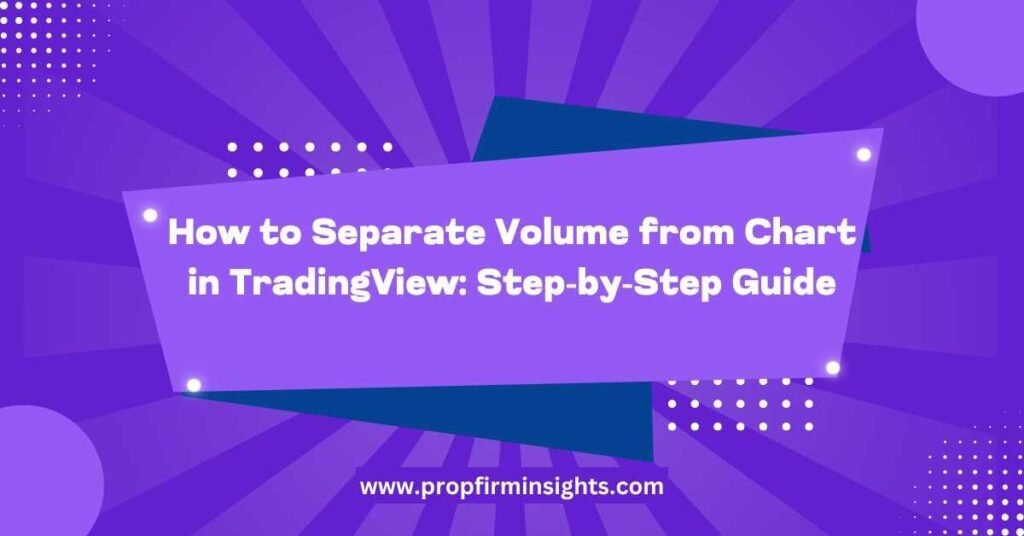Introduction
Volume data is one of the most insightful tools available to traders, offering a look into the level of participation behind price movements. In TradingView, separating volume from the main chart allows for a cleaner analysis, making it easier to spot trends, validate breakouts, and identify potential reversals. While basic volume analysis can be beneficial, there are advanced techniques that can take your understanding of volume to the next level. This article will explore advanced tips for using volume data in TradingView, including customizing volume indicators with Pine Script, setting up volume-based alerts, and integrating volume with other technical indicators. Whether you’re an experienced trader looking to refine your approach or a beginner eager to learn more, these tips will help you maximize the value of volume data in your trading strategy and make more informed decisions.
1. Customizing Volume Indicators with Pine Script
Pine Script, TradingView’s built-in scripting language, offers advanced customization options for volume indicators. You can create custom volume bars, add moving averages to the volume pane, or develop unique volume-based indicators tailored to your trading style. For example, using Pine Script, you can code volume alerts that trigger when volume exceeds a certain threshold, helping you catch significant market movements.
2. Setting Up Volume Alerts for Key Trading Signals
Volume alerts can be a game-changer in trading, notifying you when specific volume conditions occur, such as spikes or sustained high volume. In TradingView, you can set up alerts for volume thresholds that align with your trading strategy, such as alerting you to unusual activity that may indicate a breakout or reversal. These alerts keep you informed of key signals without constantly monitoring your charts.
3. Using Volume Profile to Understand Market Structure
Volume Profile is an advanced volume analysis tool that shows the distribution of volume at different price levels over a specified time period. This can help you identify areas of high trading activity, which often act as support or resistance levels. By integrating Volume Profile into your analysis, you gain a deeper understanding of market structure and can make more strategic trading decisions.
4. Integrating Volume Data with Moving Averages
Combining volume data with moving averages can provide additional insights into market trends. For instance, overlaying a moving average on your volume pane can help smooth out short-term fluctuations, allowing you to focus on longer-term trends in trading activity. This can be particularly useful for identifying the sustainability of price movements and validating trend strength.
5. Leveraging Volume-Weighted Average Price (VWAP)
VWAP (Volume-Weighted Average Price) is a popular tool among traders, providing a measure of the average price at which a security has traded throughout the day, based on both price and volume. VWAP is often used as a benchmark to assess the market’s direction and gauge the quality of executions. Integrating VWAP with separated volume data can give you a comprehensive view of market activity and help refine your entries and exits.
6. Using Volume Oscillators for Divergence Analysis
Volume oscillators, such as the Volume Oscillator or Chaikin Money Flow, provide additional ways to analyze volume data. These tools can help identify divergences between price and volume, signaling potential reversals or continuation patterns. By using oscillators in conjunction with separated volume, you can enhance your ability to spot subtle shifts in market sentiment that may not be immediately visible through price alone.
7. Analyzing Volume Clusters for Key Levels
Volume clusters refer to areas where a significant amount of trading has occurred within a specific price range. These clusters often represent key levels of support or resistance. By analyzing volume clusters in a separated volume pane, you can identify important price levels that may influence future market behavior, allowing you to make more strategic trading decisions.
8. Best Practices for Volume Customization in TradingView
To get the most out of volume data, it’s important to follow best practices for customization. This includes adjusting the scale and colors of the volume pane, integrating complementary indicators, and regularly reviewing your settings to ensure they align with your trading strategy. Proper customization not only improves the readability of volume data but also enhances your overall trading setup.
Conclusion
Advanced volume analysis in TradingView provides traders with powerful tools to gain deeper insights into market activity and make more informed decisions. By customizing volume indicators with Pine Script, setting up strategic alerts, and integrating volume with other technical tools, you can refine your trading approach and enhance your ability to identify key market signals. Whether you’re using Volume Profile to understand market structure, leveraging VWAP as a benchmark, or analyzing volume clusters for support and resistance, these advanced techniques will help you maximize the value of volume data in your trading. Start exploring these tips on TradingView today, and elevate your trading strategy with a more nuanced and sophisticated approach to volume analysis.
FAQs:
What is the benefit of using Pine Script for volume customization in TradingView?
Pine Script allows traders to create custom volume indicators, set alerts, and integrate volume with other data, providing a high degree of personalization and enhancing the effectiveness of volume analysis.
How can volume alerts improve my trading strategy?
Volume alerts notify you of significant changes in trading activity, such as spikes or drops, helping you stay informed of key market movements that could signal trading opportunities or potential reversals.
What is Volume Profile, and how can it be used in trading?
Volume Profile shows the distribution of trading activity at different price levels, helping identify key support and resistance areas. This tool provides insights into market structure, aiding in strategic decision-making.
How does integrating VWAP with volume data help in trading?
VWAP combines price and volume data to provide an average trading price, helping traders assess market direction and execution quality. Integrating VWAP with separated volume data offers a comprehensive view of market activity.
What are volume clusters, and why are they important?
Volume clusters are areas where significant trading has occurred within a specific price range, often acting as key levels of support or resistance. Analyzing these clusters can help traders identify important price levels and make more strategic trades.






More Stories
Inflatable Boat Fabrics by Derfabric
What Is Adanola Tracksuits Material Made Of?
What Has Been Used to Create Chrome Hearts Hats?